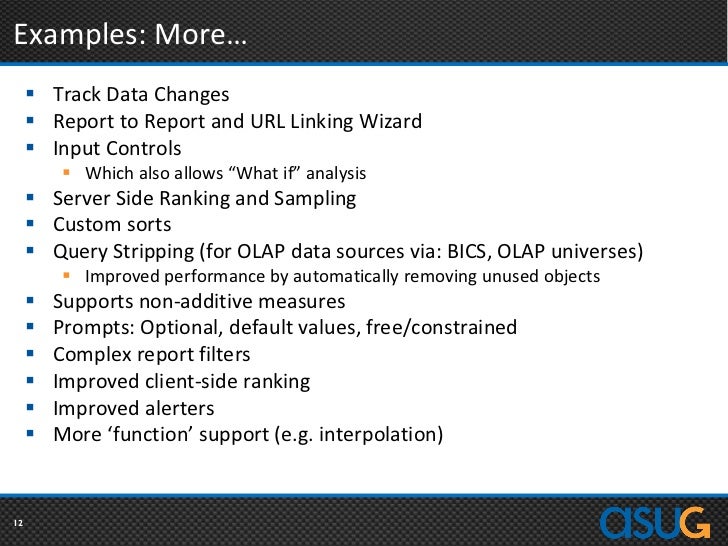Business intelligence process creates an environment for better decision-making. To make successful business decisions, you need to gain insight in business intelligence, follow the main steps of the key performance indicators (KPI) cycle, find the best source to store and process operational data, and assess and use standard business intelligence applications.
Business Intelligence Insights

Business Intelligence Software (or BI software) is a class of computer applications that process and analyze corporate data to produce quality insights, and help understand the health of your business. Download Business Objects for free. Business Objects - With Sap Business Objects you can access and analyze data with bi solution. The software is included in Business Tools. The most popular versions among Business Objects users are 11.5, 6.5 and 5.1. SAP BusinessObjects business intelligence (BI) solutions can empower your teams to. Founded in 2007, element61 is the thought-leading Business Analytics, Performance Management, Financial Reporting and Data Science consulting company in the Belgian marketplace.
- When comparing Crystal, Business Objects vs business intelligence of the Cognos solution, each of these business intelligence tools has different integration abilities but are on a level playing field for this feature.
- Business Objects 4.1. About Web Intelligence 4.1 Business Intelligence 4.1 offers two versions of Web Intelligence that can be used to create and Edit.
- Bring your data presentations into focus with this comprehensive guide to SAP BusinessObjects Web Intelligence. Updated for Webi 4.2, this book will teach you to create, design, and share your reports, while exploring the fundamentals of Webi and its extended capabilities.
- Business QAWI201 Study Tool - Business Objects Certified Professional Web Intelligence XI 3.0 (QAWI201) If these training products do not help you pass the exam, we guarantee to refund the full purchase cost. And we always have a very high hit rate on the QAWI201 Reliable Dumps Ppt study guide by our customers for our high pass rate is high as.
To help your company drive smart decisions and improve the way you do business, check out this variety of forms that can provide insight into business intelligence (BI).
Query responses: Raw data produced by the BI system, allowing the user to draw immediate conclusions
Reports: Structured and formatted data, built as part of a scheduled event, or on the fly as an ad hoc report
Derived Analysis: Insights produced by interpretation of a front-end system’s output, after that application has applied rules, heuristics, other business information, and context to it, such as in a dashboard or scorecard
Essential Steps of the Key Performance Indicators Cycle
Business intelligence (BI) is an activity, tool, or process that allows businesses to create clarity and support around their decision-making approach by determining key performance indicators (KPIs). The success level of any business endeavor can almost be measured or quantified in some aspect:
Step 1: Build or define the core business strategy or objectives

Step 2: Specify progress metrics (KPI’s), and define thresholds that indicate degrees of success.
Step 3: Measure performance over time as a baseline
Step 4: Adjust tactics and gauge correlative changes in success metrics
Step 5: Apply lessons to subsequent strategy definition
But business intelligence is very much a cultural phenomenon, moving away from gut-feel strategic choices and moving toward an evidence-driven rational approach to business.
Common Operational Data Sources in Business Intelligence
Businesses digitally store a tremendous amount of operational data, and for business intelligence to function, it needs wide-open roads between data sources. Mainframe legacy systems still form the foundation of many companies’ data centers because of their ability to process and harbor huge quantities of data, but their data is notoriously difficult to get to as many of the legacy applications are obsolete, proprietary, or pre-standards software. Other options for data sources are:
Enterprise Resource Planning (ERP): Often implemented throughout the organization in modules that map to specific business domains, such as supply-chain, human resources, finance, accounts payable, and so on. ERP systems store a lot of transactional data used in today’s BI environments.
Customer Relationship Management: A common data source for business intelligence, CRM systems do just what they say: they process and store customer profile and behavior information, like purchase activity.
E-Commerce: Web applications can act as source data systems for business intelligence platforms by feeding real-time sales activity.
Common Business Intelligence Applications
When choosing a business intelligence application, your goal is put an effective Business Intelligence (BI) solution into place, and you’re looking at processes and software. This list represents some of the more frequently used BI applications:
Source Data
Microsoft: SQL Server, Access
Oracle: Oracle 11g
SAP: N/A
IBM: DB2
Business Objects: N/A
ETL, Data Integration, Warehousing
Microsoft: Integration Services aka SSIS (formerly known as DTS)
Oracle: Warehouse Builder
SAP: SAP BW
IBM: DB2 Data Warehouse, Warehouse ManagerWebSphere DataStage (ETL) IBM Information Server
Business Objects: Business Objects XI R2: Data Integrator (ETL) Data Federator (virtualization) Rapid Marts (standard platform data marts)
Business Objects Web Intelligence Rich Client
Query and Analysis
Microsoft: SQL Server Analysis Services, Access, Excel
Oracle: Warehouse Builder, Oracle Hyperion Essbase
SAP: Netweaver BI
IBM: Various
Business Objects: Business Objects XI R2: Web Intelligence (query tool) Voyager (OLAP) Desktop Intelligence (query tool)
Reporting, Information
Microsoft: SQL Server Reporting Services, Access
Oracle: BI Suite Enterprise & Standard Editions: query, analysis, reporting, Siebel Answers, Interactive Dashboards
SAP: Netweaver BI
IBM: BIRT, Design Studio, Alphablox
Business Objects: Crystal Reports
Other Front-End Tools
Business Objects
Microsoft: Excel Pivot Tables, PerformancePoint 2007 (enterprise scorecarding)
Oracle: Oracle Data Mining
SAP: Netweaver BI
IBM: IBM Intelligent Miner (data mining)
Business Objects: Crystal Xcelsius (visualization tools), Crystal Vision (dashboard), InfoView (BI portal)
Specialty Apps
Business Objects Tutorial
Microsoft: MS Sharepoint Server 2007 (report distribution)
Oracle: Business domain operational analytics applications, Hyperion System 9 Financial Management, Financial Planning
SAP: ERP Software, Financial Analytics (formerly Outlooksoft)
IBM: Websphere Content Discovery (unstructured search)
Business Objects: Information OnDemand (hosted BI solutions), Performance Management (Formerly Cartesis)